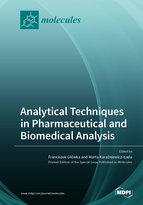Analytical Techniques in Pharmaceutical and Biomedical Analysis
A special issue of Molecules (ISSN 1420-3049). This special issue belongs to the section "Analytical Chemistry".
Deadline for manuscript submissions: closed (30 November 2022) | Viewed by 51880
Special Issue Editors
Interests: bioanalysis of drugs; metabolites and endogenous compounds using different analytical techniques, especially HPLC; pharmacokinetics; clinical pharmacokinetics; bioavailability and bioequivalence study
Special Issues, Collections and Topics in MDPI journals
Interests: bioanalysis; HPLC-MS/MS technique; method validation; pharmacokinetics; pharmacogenetics
Special Issues, Collections and Topics in MDPI journals
Special Issue Information
Dear Colleagues,
The development and validation of new analytical and bioanalytical methods play a critical role in drug discovery and therapeutic drug monitoring. The most common challenges that arise during method development are the use of an appropriate sample pretreatment technique for isolating a substance from the matrix and the choice of analytical method for the separation and final determination of the target compounds on the basis of their physicochemical properties.
Therefore, it is our pleasure to invite authors and members of their research groups to submit an article for a Special Issue of Molecules titled “Analytical Techniques in Pharmaceutical and Biomedical Analysis”, for which we serve as Guest Editors. This Special Issue aims to cover research trends in the development of analytical and bioanalytical methods that are relevant to the isolation, identification, and determination of substances in biomedical and pharmaceutical matrices. Original research papers and reviews on interesting developments related to sample preparation, separation techniques, and spectroscopic methods, as well as any novel techniques for small molecules, peptides, monoclonal antibodies, aptamers, etc., are very welcome.
The submission deadline is 31 July 2021, but we strongly encourage authors to respond to confirm their contributions with their proposed titles by 31 January 2021.
All manuscripts will undergo comprehensive review according to standard journal procedures and policies.
Thank you for considering our invitation.
Dr. Franciszek Główka
Dr. Marta Karaźniewicz-Łada
Guest Editors
Manuscript Submission Information
Manuscripts should be submitted online at www.mdpi.com by registering and logging in to this website. Once you are registered, click here to go to the submission form. Manuscripts can be submitted until the deadline. All submissions that pass pre-check are peer-reviewed. Accepted papers will be published continuously in the journal (as soon as accepted) and will be listed together on the special issue website. Research articles, review articles as well as short communications are invited. For planned papers, a title and short abstract (about 100 words) can be sent to the Editorial Office for announcement on this website.
Submitted manuscripts should not have been published previously, nor be under consideration for publication elsewhere (except conference proceedings papers). All manuscripts are thoroughly refereed through a single-blind peer-review process. A guide for authors and other relevant information for submission of manuscripts is available on the Instructions for Authors page. Molecules is an international peer-reviewed open access semimonthly journal published by MDPI.
Please visit the Instructions for Authors page before submitting a manuscript. The Article Processing Charge (APC) for publication in this open access journal is 2700 CHF (Swiss Francs). Submitted papers should be well formatted and use good English. Authors may use MDPI's English editing service prior to publication or during author revisions.
Keywords
- Bioanalysis
- Biopharmaceutics
- HPLC
- GC
- Electrophoresis
- Mass spectrometry
- Pharmacokinetics
- Pharmaceutical analysis
- Pharmaceutical formulation
- Plant materials
- Spectroscopy
- Validation








